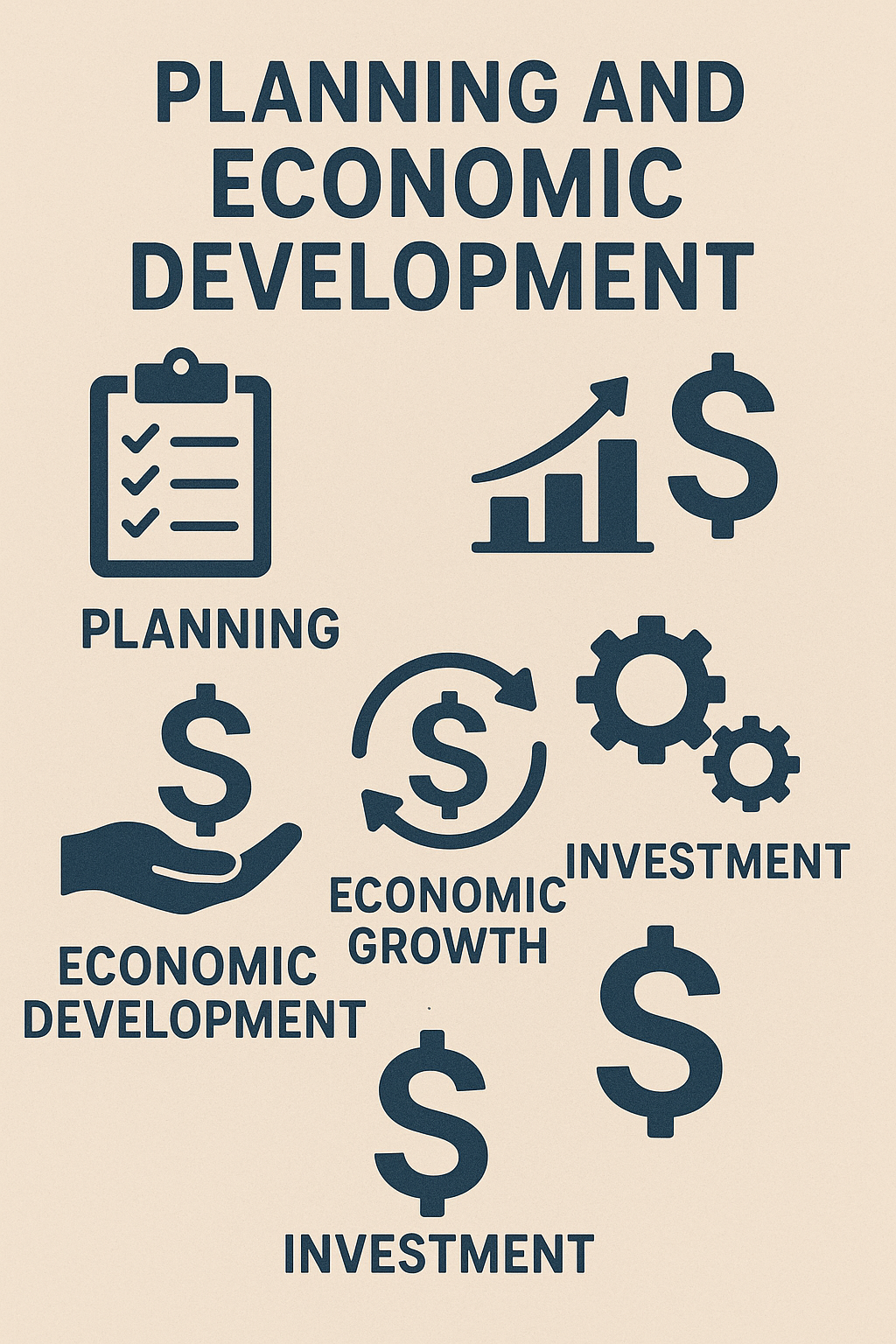
27 Jul Planning and Economic Development
Planning and Economic Development – UPSC Economics Optional Paper 1
Planning and economic development have been cornerstones of post-independence India’s policy architecture. For UPSC aspirants with Economics as an optional, understanding the theories of planning, models, institutions like the Planning Commission and NITI Aayog, and the history of five-year plans is essential. This article presents detailed notes on the topic “Planning and Economic Development” as part of the UPSC Economics Optional Paper 1 syllabus.
📊 Infographic: Planning and Economic Development

planning economic development_infographic
🧠 Mind Map: Key Concepts in Planning and Economic Development
planning economic development mindmap
1. Introduction to Economic Planning
Economic planning refers to the deliberate and organized effort by the state to allocate resources effectively to achieve specific developmental goals. In the context of developing countries, planning is essential for overcoming structural constraints, ensuring equity, and guiding long-term development strategies.
2. Objectives of Planning
- Accelerated economic growth
- Reduction of poverty and inequality
- Modernization and industrialization
- Employment generation
- Balanced regional development
- Environmental sustainability
Graduation degree with IAS coaching
3. Types of Planning
3.1 Directive Planning
The state has control over major sectors and actively directs investment decisions. Common in socialist economies.
3.2 Indicative Planning
Used in mixed economies, it relies on market signals with government setting broad targets and providing incentives.
3.3 Rolling Plans
Flexible plans that are revised annually. Popular in the post-emergency period in India (1978-80).
3.4 Perspective Planning
Long-term (15-20 years) strategic framework, such as India Vision 2020.
4. Planning Models
4.1 Harrod-Domar Model
Emphasizes savings and capital-output ratio as key determinants of growth. Growth rate (g) = s/v.
4.2 Mahalanobis Model
Used in India’s Second Five-Year Plan. Advocated investment in heavy industries (Capital goods sector). Based on two-sector and later four-sector models.
4.3 Input-Output Model (Leontief)
Helps in estimating inter-sectoral flows of goods and services. Useful for detailed planning of industrial structure.
4.4 Linear Programming
Optimizes resource allocation under constraints using mathematical techniques. Applied in agriculture, infrastructure, and logistics planning.
Best ias coaching in hindi medium
Best mentorship programme for upsc
Best ias coaching in chandigarh
5. India’s Planning Experience
5.1 Planning Commission (1950–2014)
- Set up by a resolution of Government of India in 1950.
- Tasked with drafting Five-Year Plans and allocation of central assistance to states.
- Criticized for top-down approach and bureaucratic delays.
5.2 NITI Aayog (Since 2015)
- National Institution for Transforming India
- Emphasizes cooperative federalism and bottom-up planning
- Think tank approach rather than resource allocator
- Promotes innovation, digital governance, sustainable development goals (SDGs)
6. Evolution of Five-Year Plans in India
| Plan | Period | Focus |
|---|---|---|
| 1st Plan | 1951–56 | Agriculture, irrigation |
| 2nd Plan | 1956–61 | Mahalanobis Model, heavy industries |
| 3rd Plan | 1961–66 | Self-reliance, defense |
| 4th Plan | 1969–74 | Growth with stability |
| 5th Plan | 1974–79 | Poverty removal, employment |
| 6th Plan | 1980–85 | Technology, modernization |
| 7th Plan | 1985–90 | Food, work, productivity |
| 8th Plan | 1992–97 | Liberalization, reforms |
| 9th Plan | 1997–2002 | Inclusive growth |
| 10th Plan | 2002–07 | Reduction in poverty and GDP growth of 8% |
| 11th Plan | 2007–12 | Faster and more inclusive growth |
| 12th Plan | 2012–17 | Faster, sustainable, and more inclusive growth |
7. Achievements of Planning in India
- Rise in per capita income and GDP
- Industrial base creation (steel, power, transport)
- Green and White Revolutions
- Infrastructure development – roads, ports, education
- Focus on equity, poverty reduction and rural development
8. Criticism of Planning in India
- Over-centralization and lack of flexibility
- Implementation failures and leakages
- Neglect of private sector and entrepreneurship in earlier phases
- Unrealistic targets and lack of accountability
- Red tape and bureaucratic inertia
9. Contemporary Relevance of Planning
Despite dismantling of the Planning Commission, strategic planning remains relevant. NITI Aayog’s focus on digital economy, sustainability, and cooperative federalism aligns with 21st-century development needs.
📚 Previous Year UPSC Questions on Planning
- Discuss the evolution and relevance of economic planning in India. (2021)
- Critically examine the contribution of Five-Year Plans towards poverty alleviation in India. (2019)
- What is the difference between indicative and directive planning? Explain with Indian examples. (2018)
🔮 Probable Questions for Upcoming UPSC Prelims and Mains
- How does NITI Aayog differ from the Planning Commission in structure and function?
- Evaluate the relevance of Mahalanobis model in the current economic context.
- Discuss the importance of perspective planning for sustainable development.
- What lessons can India draw from its five-year planning experience?




No Comments